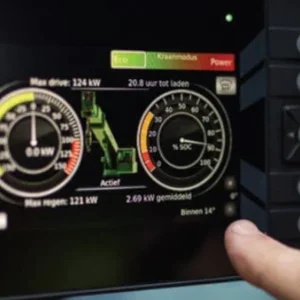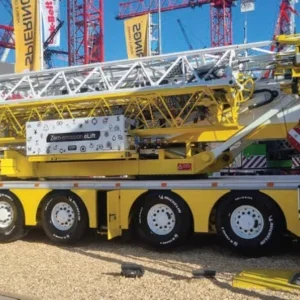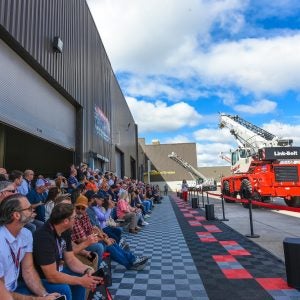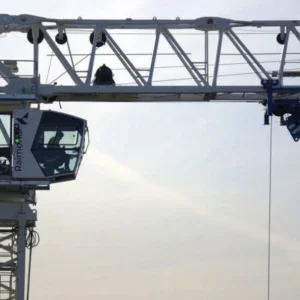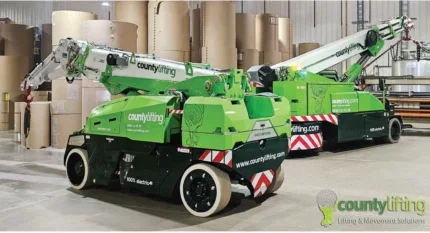
The first spider crane from Japanese company Maeda. It was launched in 1982. Before that there were compact or small lifting machines but none with the distinctive spider-like outriggers that define modern spider cranes.
According to some accounts Maeda designed these cranes as a solution to work in the narrow spaces between tombstones in Japanese graveyards.
Japanese cemeteries are often crowded with tightly packed gravestones and narrow pathways making it nearly impossible for traditional cranes or large machinery to operate. Maeda’s compact spider cranes, with their small footprint, extendable outriggers, and precise controls, allow workers to carefully lift and position heavy stone monuments without disturbing nearby graves.
This application is especially important in Japan where respect for ancestral graves is a major cultural value and careful handling of the stones is essential.
Maeda’s vision laid the path for the development of the modern mini crane and now spider cranes, and their crawler tracked minicrane counterparts, are used for lifting applications in all types of environments (especially confined ones) all around the world.
And there is a plethora of choice available for users. To best suit the application environment the power source can be specified to be electric, hybrid, or diesel. And, depending on ground conditions, tracked mini-crawlers (for rough terrain) or spider cranes (for smoother ground) can be specified.
Dimensions come into play, too, with some mini cranes being ‘more mini’ than others. To contextualise, mini crane manufacturer UNIC’s range stretches from the ultracompact URW-094 (width 595mm, working radius 5.17m) to the mega URW-1006 (two metres wide, with 21.9m working radius.)
There really are manufacturers and mini-cranes available to fit all requirements. So, with this in mind, what’s new on the market?
LITHIUM-POWER
The industry’s newest mini crane is from Italian manufacturer Jekko which launched the JF235CL in November 2024. It is Jekko’s first lithium-powered knuckle boom crawler and is the fully-electric version of its diesel-powered JF235, offering the same features and lifting performances as that model. It reaches a height of 25m, a radius of 23m, and has a lifting capacity of 6.15 tonnes, with lifting diagrams unchanged from its internal combustion brother. The days when one expected to sacrifice the capacity and power of diesel in return for sustainability and emissions-free battery power are no longer with us.
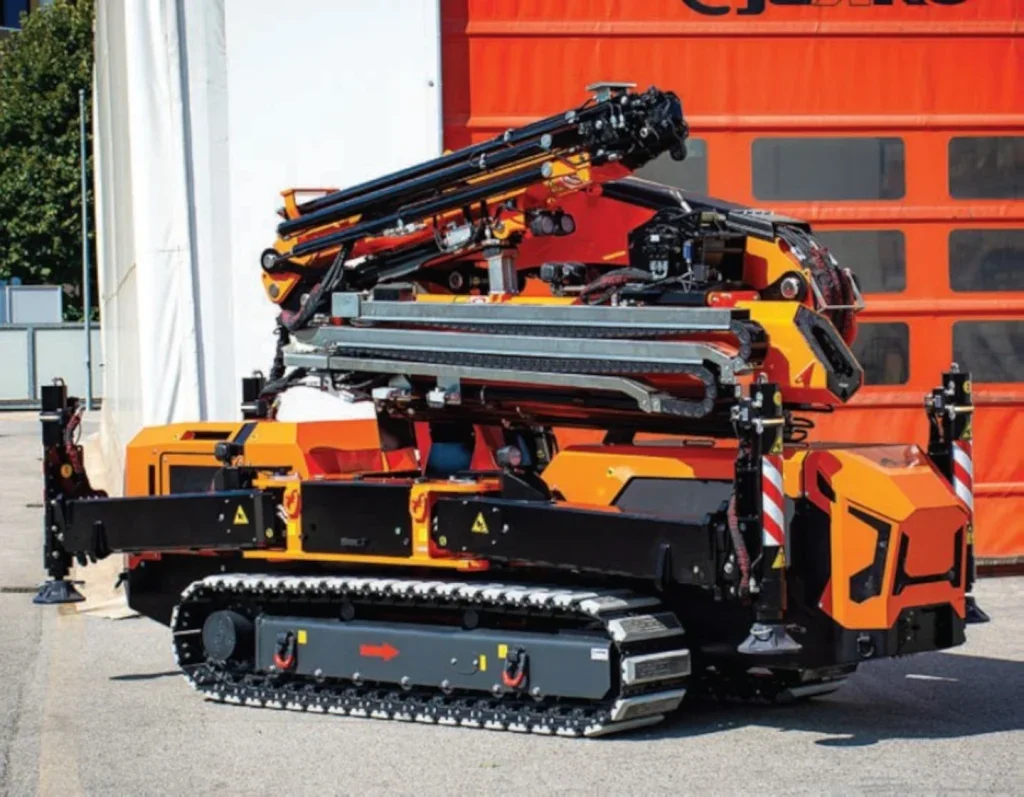
Like its diesel forerunner the JFL225L has an articulated boom, fully flexible in every movement. It is available with accessories such as fly jib, searcher hook, manual extensions and a man-working platform. Power is from a 48V 67kWh lithium-ion battery pack which is monitored by a BMS (battery monitoring system) fully integrated into the machine’s electronics for safety. As with all electric power, maintenance and servicing are only needed at longer intervals and are much simpler than with diesel; indeed, in comparison, they are virtually maintenance-free.
The low voltage battery allows troubleshooting without the need of a dedicated service licence. As well as being low voltage the battery is high capacity: it can power the 12kW motor pump for ten working hours on a 35% duty cycle. A ‘Start&Stop’ system on the pump gives a considerable further savings in energy and reduces the hydraulic maintenance needs.
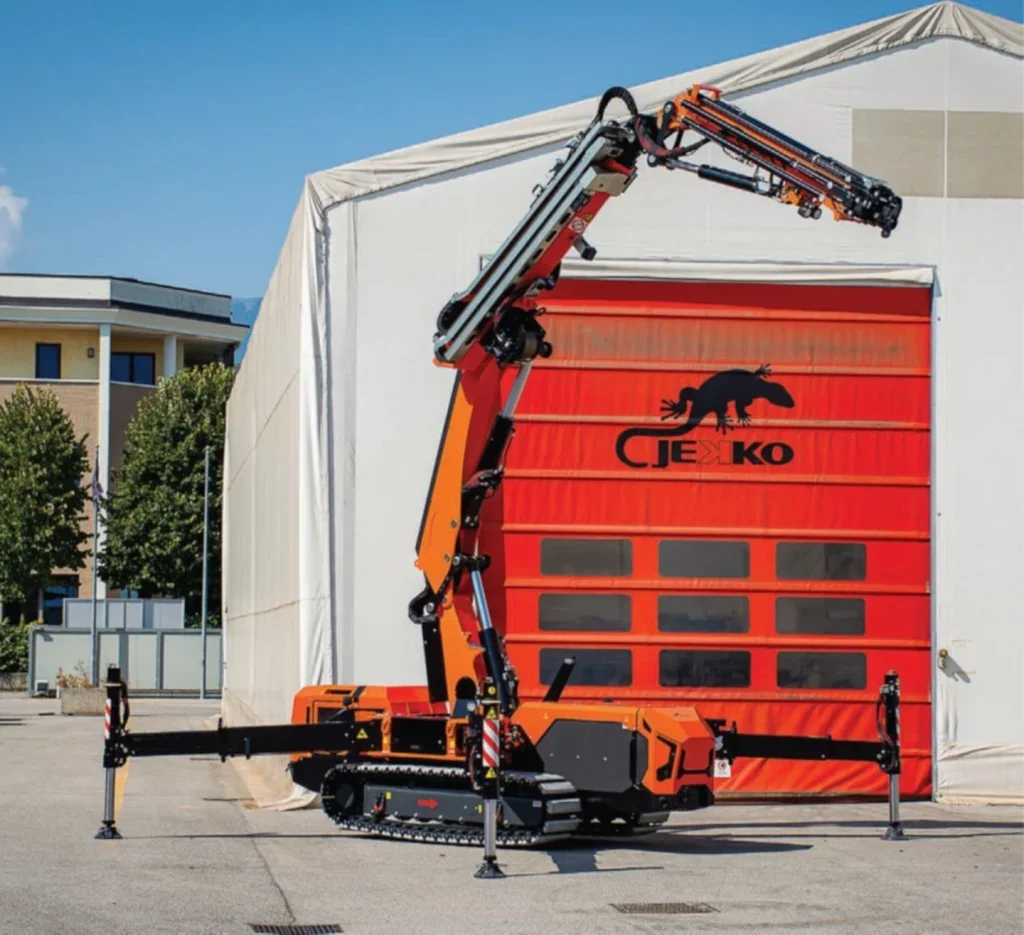
(The ‘virtually maintenancefree’ phrase used above applies to the crane’s electric motors; it does not include the hydraulics, the requirements of which are much the same as in a dieselpowered machine). The crane can be recharged with both singlephase (230V) or three-phase (400V) chargers. The complete recharge, from zero to 100%, can be completed in six-and-a-half hours and the crane can continue to operate at full power during that recharging period.
NARROW TRACK
Last summer Maeda launched a new MK series model: the MK3053C. It has a capacity of 2.98 tonnes at 1.8 metres, a maximum working radius of 14.3 metres, and a maximum lifting height of 16.95 metres. The main boom has a four-fall hook mode; there is full proportional radio control, automatic and stepless multiple outrigger settings, and a detachable negative-angle jib which can be attached by one operative working alone.
Dimensions are all-important for a mini-crane – it is, after all, a large reason for their existence: being small enough to get into residential buildings and confined spaces is why they were devised in the first place.
The MK30353C is 3,195mm long by 1,945mm high by a remarkably narrow 780mm wide when the tracks are retracted for tight access. They can extend, however, to 1050mm. White rubber tracks can be supplied for non-marking indoor use. Maeda claims that it is this model is more versatile than its predecessors. Full radio control and stepless outriggers allow it to be used in any working space, it claims.
CHAIN GANG
Manitex Valla has invested in the development and production of four new heavy pick-and-carry cranes in its successful V-range.
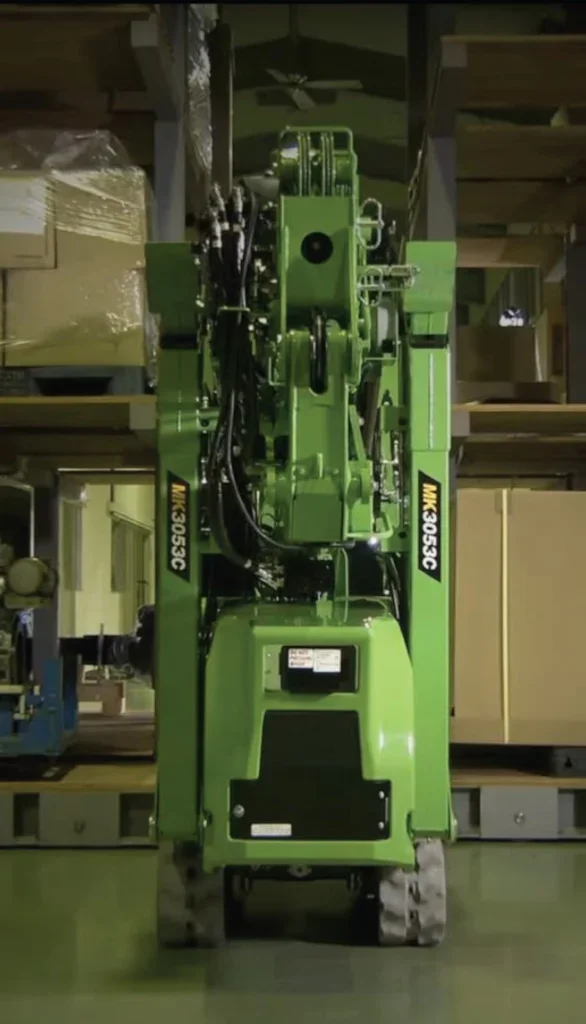
These are battery-powered machines, now with capacities ranging from 3.6t for the smallest V36R up to the 21t capacity V210R, which has a working radius of 8.1m and a maximum working height of 12.5m.
All these can be supplied as radio-controlled walk-beside models; the larger capacity machines, from the 16t-capacity V160R, are also offered as or as ride-on cabined versions. The largest model of all, the 25t 250E, is ride-on only.
These models have hooks fixed in relation to the boom. Vertical lifting therefore involves raising the boom. In November Manitex Valla increased its range of accessories by adding a chain lifter. It fits on to the end of the boom and allows vertical lifting without moving the boom.
It can be applied to all VR series machines: it has a maximum capacity of five tonnes and a chain stroke of one metre but is available also with greater capacities and strokes on request.
TRACKED CARRIERS
Alongside the march of the mini crane a similarly small-sized machine is also making itself felt, often in the same environments: the tracked carrier.
It, too, manoeuvres around constricted sites and can even be found on upper floors of high-rises under construction for incredibly, given the right accessory, the machines can even climb stairs.
Before a mini crane can lift its load the load has to be transported to the crane. Manpower used to be the option; but manpower, even if possible, is far from ideal. The human body has better things to do than strain and possibly injure itself carrying heavy loads around.
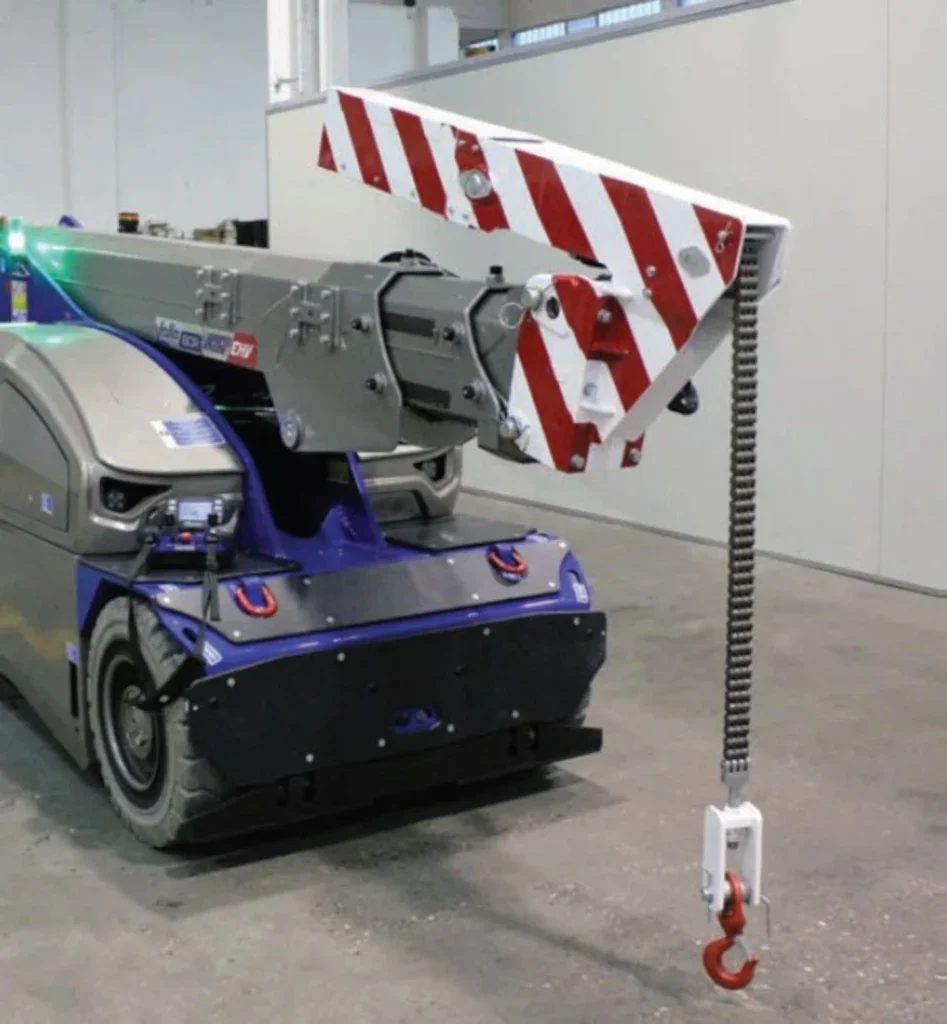
So for fitting, say, glazing panels or light curtain walling in a high-rise from the inside; or bringing a steel beams into position for a mini-crane to lift; or for carrying pallets of bricks or of blocks around a low-rise residential construction site, a mechanised solution is useful. The mini tracked carrier is exactly that solution.
It is what it says on the tin: a flat carrying platform mounted on rubber tracks. It is perhaps surprising to hear that the first one, in the modern sense, was created more than 50 years ago: back in 1971 Yanmar mounted a rectangular carrying tray on the chassis of, of all things, a tracked combine harvester to carry material round construction sites.
Larger such machines compete with dumper trucks on big outside projects. But it is only in recent years that the flat-topped mini tracked carrier has come into its own, on small and medium-sized projects, indoors and out.
The reason is simple, and it’s much the same as the reason that the mini crane is flourishing: electric power.
PERFECT MARRIAGE
So the modern small tracked carrier is a silent machine, emissionless, that exerts low ground pressure on mud or concrete slab. It is compact and, like its mini crane companion, can go anywhere and carry anything.
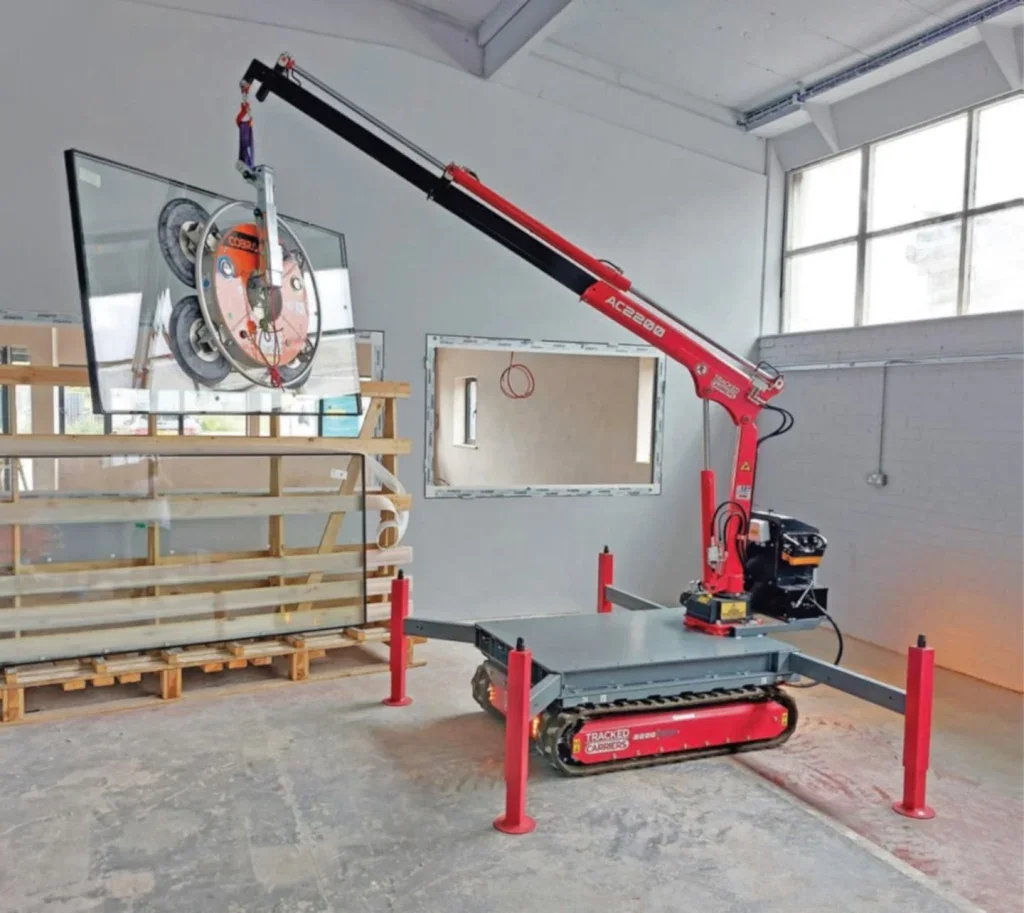
The flatbed that tops it can be multi-purpose, customisable, and easily adapted for almost any load that a mini crane might be capable of lifting. The mini crane and the mini tracked carrier seem a marriage made in heaven.
They share workspaces and, indeed, manufacturers and suppliers, too. UK mini crane expert GGR Group, for example, also supplies a range of tracked carriers: from the TC1, which has a capacity of 1200kg, to the 3.0FX, which can carry 3000kg. These all have 360-degree turntables to aid in positioning the load; dollies are available to, for example, help manoeuvre one end of a beam while the carrier takes the weight of the other end.
Essex-based tracked carrier manufacturer Tracked Carriers has a range of five machines with capacities from 300kg, for the 300L model, up to 4,000kg, for the 4000 Pro. All are battery-powered. All are compact (even the 4000Pro is only one-metre wide). And all, except the smallest, have fullyproportional remote control (the 300l has two-speed RC).
Accessories include rotating platforms (to help navigate or unload long loads in confined spaces), fifth wheels and dollies (again for carrying long loads such as beams), pallet cradles, corner posts (for securing loads such as timber), winches, A-frames (for carrying glass), and even a dozer blade, and a stair climbing kit.
The latter consists of a balance handle, a backstop and a set of steel triangles to get the machine started on the lower steps.
As is clear from the above, the tracked carrier is very versatile.
There are variants on the theme. On sloping sites the load might fall from the flat top of the carrier. Enter GGR’s self-levelling carriers: the ‘Tracked Leveller’ series. These have an automatically self-levelling bed which stays horizontal no matter what slopes, or side-slopes, the machine is traversing. It can cope with inclines in either direction of up to 25°.
PICK AND CARRY
So tracked carriers work well with mini cranes but you could combine crane and tracked carrier into a single machine. The full-sized pick-and-carry deck crane is more used in the US than in Europe. Broderson, for example, with corporate headquarters in Illinois, manufactures them; but the smallest in its range, the IC-20, qualifies as a mini crane, being a compact 4 ft (1.2 metres) wide, and has a carry deck above the front wheels. It has a three-section 15 foot (4.6) main boom and a capacity of 2.5 tonnes. Unlike the mini cranes we have mentioned above its power is diesel but it has a dual-fuel option.
CARRIER WITH CRANE
You could describe that as a crane with a carrier deck attached. Alternatively, you could go for a carrier with a crane attached.
Tracked Carriers, as above, offers a knuckleboom attachment for its larger carriers. Its power is taken from a smart auxiliary output socket, featured on all 1200 PRO machines, which provides power on demand for the hydraulic pump within the crane, and also disables drive functions once the crane is operational.
GGR has a similar arrangement in its ‘Tracked Leveller 5.5 with crane’ machine. The crane has a lifting capacity of up to 990kg, a slewing angle of 105° and a reach of 2m to 4.3m, depending on the weight of the load. GGR says the machine is perfect for lifting and placing materials such as steel and timber for transportation across construction sites.
‘Maxi’ cranes, of course, have their uses; we would be in trouble without them. But mini-cranes and mini-transporters certainly have a place in the scheme of things, especially when they work in harmony together. Small but perfectly formed?
HOEFLON C10 SPIDER CRANE FOR SUSTAINABILITY SPECIALIST CADMAN CRANES
Essex-based Cadman Cranes has added a Hoefl on C10 spider crane to its fl eet. Cadman’s diverse fleet includes a wide range of mobile cranes and a unique selection of spider cranes and compact crawler cranes, as well as specialist lifting and grab equipment, but this is the first time that the company has invested in the Hoefl on brand.

With a maximum lifting capacity of 4.0te, the Hoefl on C10 has a maximum 21m vertical reach with a SWL of 750kg, and a maximum radius of 19.8m with a SWL of 209kg. Nevertheless the machine weighs only 5t and is narrow enough to fit through doorways, making it ideal for getting into tight spaces and manoeuvring in difficult locations, both internally and externally. The Hoefl on C10 also has hydraulically extendable and retractable tracks, meaning that it can access narrow and hard to reach areas.
Cadman has become renowned as a sustainable crane hire business, setting the gold standard in the industry and winning sustainability awards for its practices, including The Carbon Neutrality Award at the Anglian Water Supplier Awards. It aims to become the most sustainable mobile crane hire business in the UK. Tapping into Cadman Crane’s outstanding environmental credentials the Hoefl on has a hybrid engine which runs on HVO – the company runs its entire fl eet solely on sustainable HVO fuel. It can also be operated on a direct feed 400V 3 phase power supply, which is ideal for working indoors with no emissions.
“This powerful new crane will enhance our ability to tackle challenging lifting projects in confi ned spaces, while also supporting our ongoing commitment to sustainability,” says Matt Waddingham, managing director of Cadman Cranes. “The Hoefl on C10 is an exciting addition to our fl eet, offering both versatility and environmental benefi ts, aligning perfectly with our mission to reduce the carbon footprint of our operations. We are delighted to bring this state-of-the-art crane to our clients ensuring that we can meet their lifting needs with minimal environmental impact.”
ELECTRIC-FOCUSSED FUTURE FOR COUNTY LIFTING WITH NEW JMG CRANES
Kettering, UK-based crane and specialised transport services provider County Lifting has expanded its fl eet with the addition of two new JMG MC100-08 electric pick and carry cranes. The cranes come with interchangeable jib length options, plus winch and fork attachments. The MC100.08 has a maximum lifting capacity of 15 tonnes.
County Lifting has a diverse fl eet, including Tadano and Liebherr mobile cranes with capacities ranging between 20 to 130 tonnes, city cranes, plus compact cranes. It already has a number of other electric machines and says it is building towards an electric-focussed environmentally responsible future. It also believes the new cranes will help open up opportunities for future expansion, whilst providing clients with a green solution to their lifting requirements.
“These electric pick and carry cranes are bringing an increased level of versatility to our fl eet,” says Daniel Drury, project manager for County Lifting. “They are allowing us to deliver an increased level of effi ciency to a broader spectrum of clients, businesses and industries.”
GGR MINI CRANE AND TRACKED CARRIER WORK TOGETHER
GGR Group was commissioned to replace a two-tonne circuit breaker in a challenging environment at a rural substation. The task involved navigating narrow access lanes and uneven terrain to remove the old breaker and install a new one. By using the capabilities of the UNIC URW-706 mini spider crane and the six-tonne tracked carrier working together, GGR Group successful overcame the site’s spatial and operational limitations.
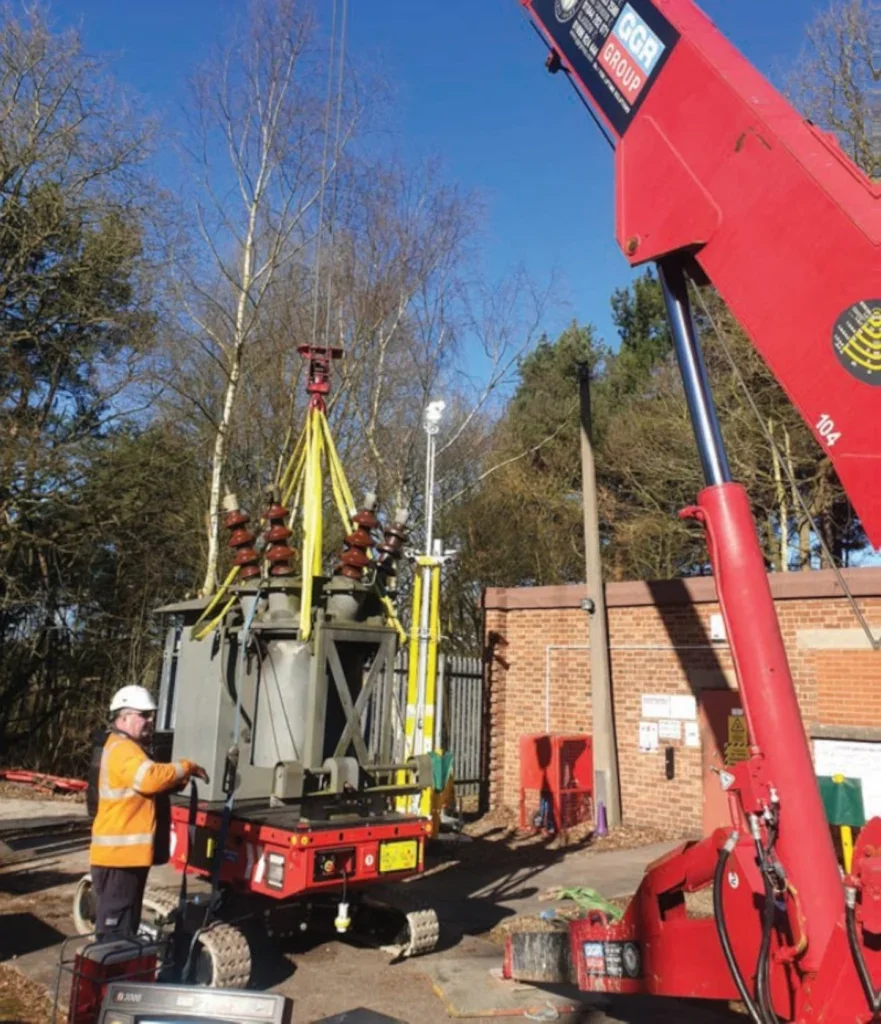
The substation’s location posed signifi cant logistical challenges. With confi ned space and narrow access lanes, manoeuvring traditional heavy machinery proved impractical. The ground was uneven, further complicating the positioning of equipment: the two-tonne circuit breaker required meticulous and precise handling to ensure the safety of both itself and the existing
To address these challenges GGR Group deployed two highly specialised pieces of equipment: the UNIC URW-706 mini spider crane and the six-tonne tracked carrier, both designed to perform optimally in confi ned spaces and demanding conditions.
The UNIC URW-706 is a highly compact and robust crane with a lifting capacity of up to six tonnes. Its narrow tracks allowed it to navigate the challenging terrain with ease. The crane successfully removed the two-tonne circuit breaker and precisely installed the new unit, ensuring minimal disruption to the surrounding infrastructure.
The six-tonne tracked carrier played a crucial role in transporting the circuit breakers, new and old, through the restricted access and rugged terrain. It was able to navigate with ease the narrow lanes and uneven ground where standard vehicles could not go. The tracked carrier safely transported the old circuit breaker to the truck for removal and delivered the new breaker to the crane for installation, ensuring an effi cient and smooth process.
PICK ‘N’ CARRY: COMPACT CRANE ON CARRIER HANDLES LOADS FOR ANATREE
Combining a crawler-mounted load carrying machine with a new crane attachment is bringing safety and productivity benefi ts to a contract lifting specialist.
UK company Anatree Group Logistics has premises in London, Leeds, and Manchester and offers lifting and logistical solutions to a growing number of clients. The company recently invested in a 2200 Pro from Tracked Carriers to help handle loads in tight spaces and on rough terrain. Anatree also purchased a new crane attachment which effectively transforms the 2200 into a pick and carry crane.
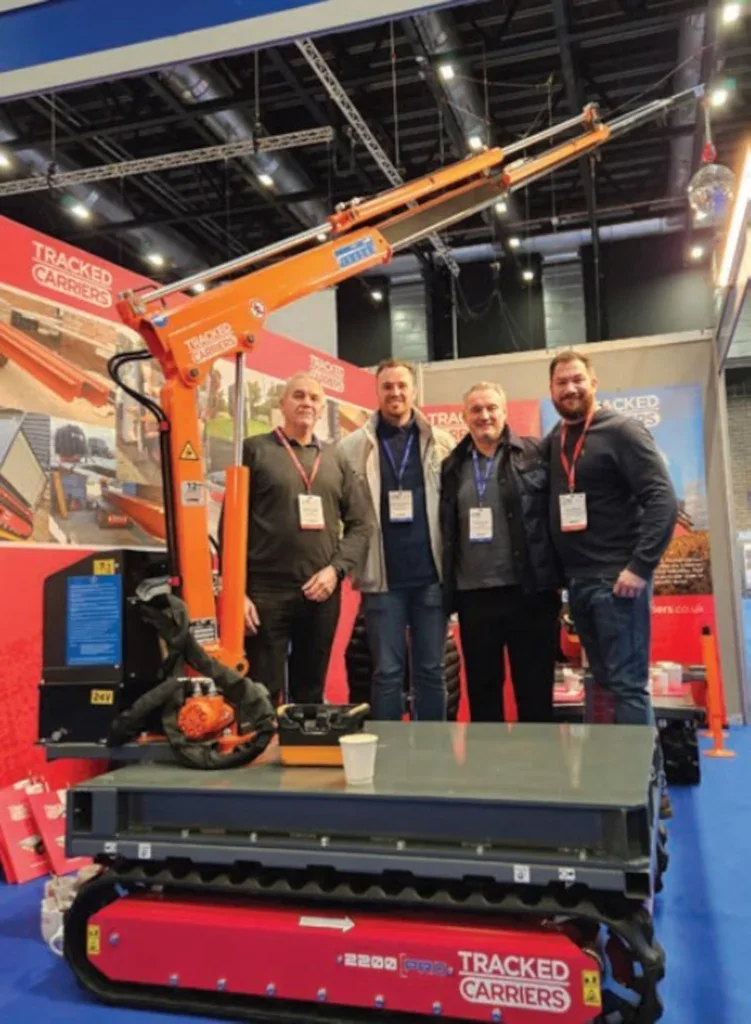
“We do a lot of work in the telecoms, healthcare and HVAC sectors,” said Anatree director Christian Elwiss-Hough. “For indoor working, non-marking tracked machines are required to protect the fl oors; The 2200 Pro is electrically powered so there are zero emissions. It aligns with our E-LIFT initiative to provide carbon neutral lifting solutions.
“We are also installing and removing a lot of cabinets and equipment in the telecoms sector. In these applications we need rough terrain capabilities but there is not always enough room to berth a crane, whereas this is much more compact. Those compact dimensions are also very useful for our healthcare and retail work such as installing air handling units.
“The best feature here is that it can carry up to 1.5 tonnes on the deck so the crane can pick it up, place it on the deck and then away we go. We trialled it on a telecoms job in a remote area and immediately saw the benefi ts. There was not room for a HIAB truck but the 2200 was the perfect solution.”
Made in the UK, Tracked Carriers are compact load-bearing machines designed for a wide range of applications. The 2200 Pro has a 2,200kg carrying capacity but is only 950mm wide. It is battery-powered with fully proportionate remote controls. The crane attachment can lift up to 990kg with 1.1m outreach, and up to 4.5m with the load reduced to 200kg. It offers two crane modes – standard and narrow. The crane is attached to the machine via eight bolts, meaning it can be quickly decoupled as required.
Peter Hough, director of Anatree Group Logistics, said: “Using the 2200 with the crane can deliver a lot of benefi ts for us. It fi ts in the back of a van, so transport is easier, lower cost, and more sustainable. We can also recharge its batteries from the solar panels at our depots, meaning it is very cost-effective to run and extremely environmentally friendly.
“On top of that its compact size means that it can eliminate a lot of the logistical headaches that come when you’re lifting with a HIAB truck or a mobile crane. Traffi c and pedestrian management schemes are reduced as there is no requirement for temporary footpath or road closures. Reduced red tape means a better experience for our clients and less admin for us, while still ensuring the highest possible safety standards.”


